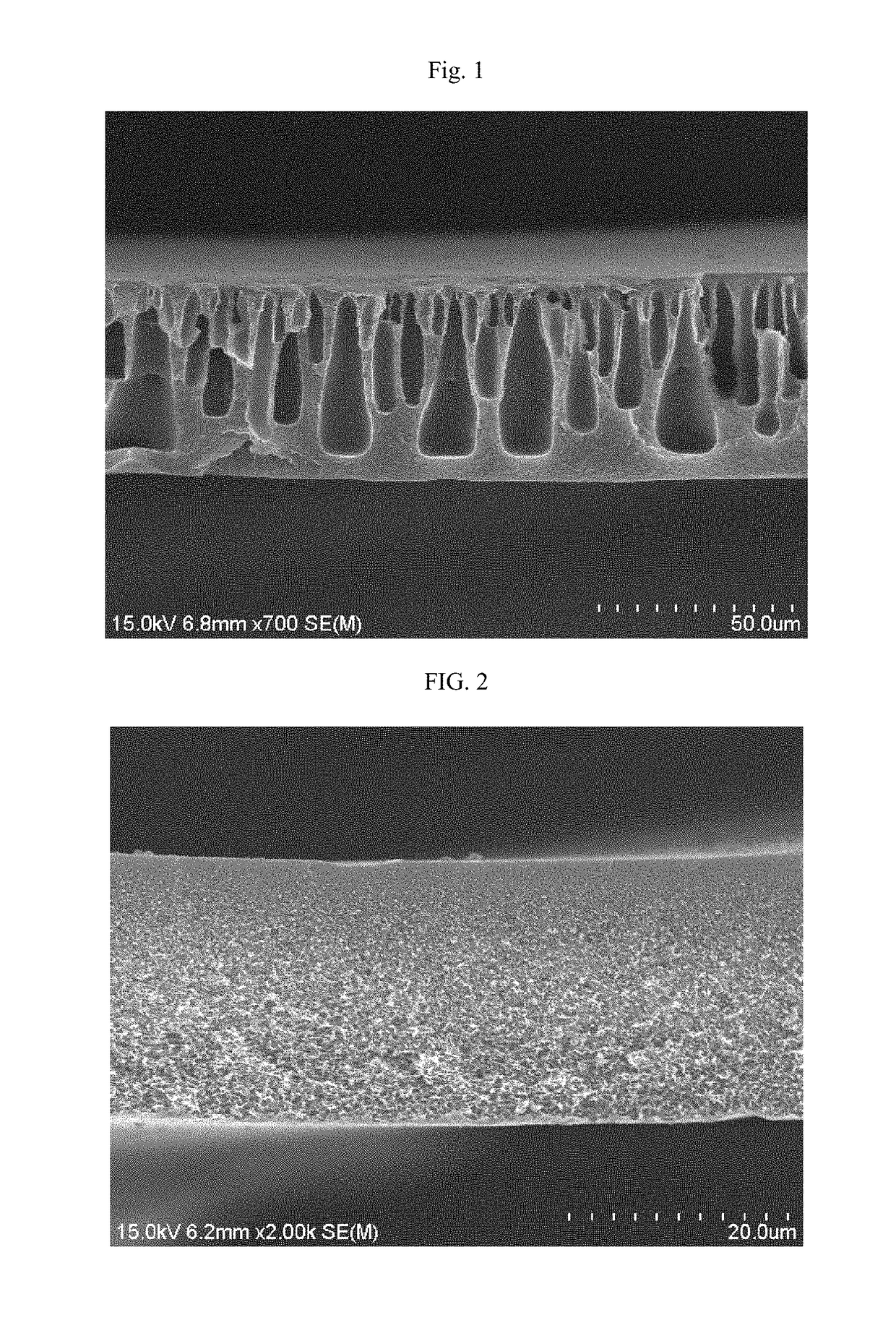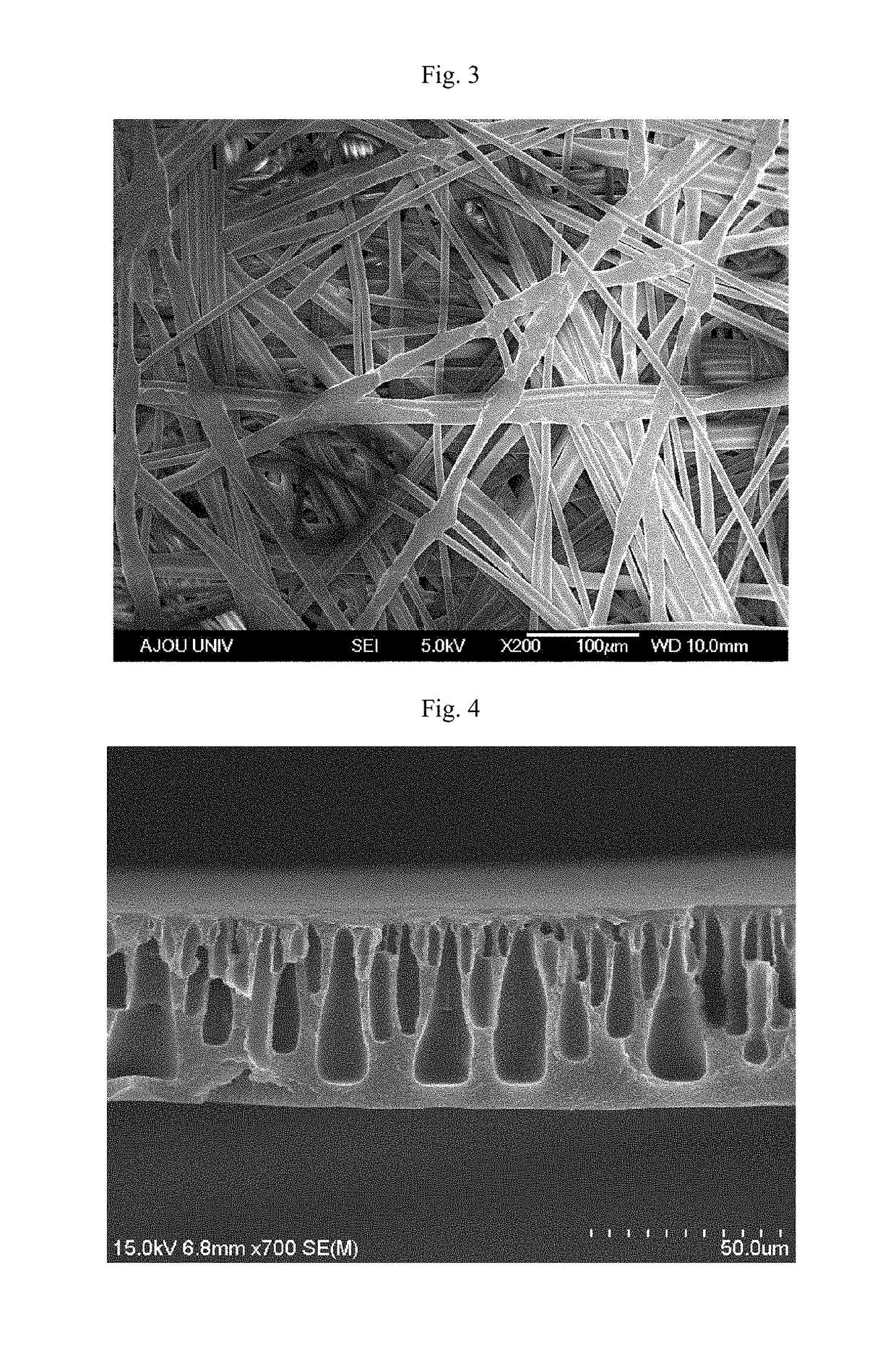Forward osmosis membrane for seawater desalination and method for preparing the same
a technology of forward osmosis membrane and seawater desalination, which is applied in the direction of filtration separation, domestic applications, separation processes, etc., can solve the problems of limited practical use, impracticality of membrane, and inability to diffuse the solution of draw solution, so as to enhance the water permeability of the membrane and the water flux, high porosity, and high porosity
- Summary
- Abstract
- Description
- Claims
- Application Information
AI Technical Summary
Benefits of technology
Problems solved by technology
Method used
Image
Examples
example 1
[0146]A solution containing 17.5 wt % of polyacrylonitrile as a hydrophilic polymer in an organic solvent was cast 50 μm thick on a glass plate and then subjected to phase transition in water used as a nonsolvent at the room temperature to form a hydrophilic polymer layer. The hydrophilic polymer layer thus obtained was kept in ultrapure water for about one day to extract the solvent. On the surface of the solvent-extracted membrane, an aqueous solution containing 2 wt % of m-phenylenediamine (MPD) was put in interfacial contact with an organic solution containing 0.1 wt % of trimesoyl chloride (TMC) in an ISOPAR solvent (Exxon Corp.) to form a polyamide layer by a polymerization reaction between the compounds, completing a composite membrane.
examples 2 , 3 and 4
Examples 2, 3 and 4
[0147]The procedures were performed to prepare a composite membrane in the same manner as described in Example 1, excepting that the membrane composition was given as presented in Table 1.
example 5
[0161]A solution containing 17 wt % of polyacrylonitrile as a hydrophilic polymer in an organic solvent was cast 50 μm thick on a nonwoven fabric 1 having an air permeability of 6.3 cc / cm2·sec as prepared by the paper making process, and then subjected to phase transition in water used as a nonsolvent at the room temperature to form a hydrophilic polymer layer. The nonwoven fabric 1 had a contact angle changed from 80 degrees to one degree over 4 seconds, with an average pore diameter of 7.5 μm. The hydrophilic polymer layer formed on the nonwoven fabric layer was kept in ultrapure water for about one day to extract the solvent. On the surface of the solvent-extracted membrane, an aqueous solution containing 2 wt % of m-phenylenediamine (MPD) was put in interfacial contact with an organic solution containing 0.1 wt % of trimesoyl chloride (TMC) in an ISOPAR solvent (Exxon Corp.) to form a polyamide layer by a polymerization reaction between the compounds, completing a composite memb...
PUM
| Property | Measurement | Unit |
|---|---|---|
| thickness | aaaaa | aaaaa |
| thickness | aaaaa | aaaaa |
| surface area | aaaaa | aaaaa |
Abstract
Description
Claims
Application Information
 Login to View More
Login to View More - R&D
- Intellectual Property
- Life Sciences
- Materials
- Tech Scout
- Unparalleled Data Quality
- Higher Quality Content
- 60% Fewer Hallucinations
Browse by: Latest US Patents, China's latest patents, Technical Efficacy Thesaurus, Application Domain, Technology Topic, Popular Technical Reports.
© 2025 PatSnap. All rights reserved.Legal|Privacy policy|Modern Slavery Act Transparency Statement|Sitemap|About US| Contact US: help@patsnap.com



